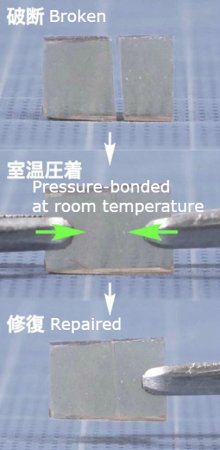The Japanese have developed "self-healing glass"
A team of researchers from the University of Tokyo, led by Professor Takuzo Aida, has created prototypes of what might be called the world's first "self-healing glass". This "glass", being broken, reconnected and placed under pressure for several hours at room temperature, fully restores its structure, gaining the original mechanical strength.

The basis of self-healing glass is polyester thiomochevin, a solid transparent polymer material that has a smooth surface. This material is used in industry as a raw material for the manufacture of other polymeric materials. It is also called the term "molecular starch" and it has the properties to hold on its surface organic molecules of biological origin, which was used in this case.
During the work, Japanese researchers synthesized and tested several polymeric materials, the structure of which is much similar to polyester thiomochevine. These materials went through a series of tests that assessed their mechanical strength and the effectiveness of the "self-healing" function. And in these experiments, the scientists found that four main conditions are necessary to create self-healing glass.
First, the material must have high local mobility relative to short polymer chains. Secondly, in order to achieve high mechanical strength, provided for short polymer chains, these chains must be connected by high-density "bridges" of hydrogen bonds, while the presence of a large number of hydrogen bonds should not lead to the crystallization of the material. And, fourthly, the structure of the material should contribute to the establishment of hydrogen bonds.
All these conditions are fully fulfilled with the use of thiomochevine polyester as the main material. And in the future, a number of new self-healing materials may be developed for different applications, based on polyester thiomochine.So
urce:www.dailytechinfo.org